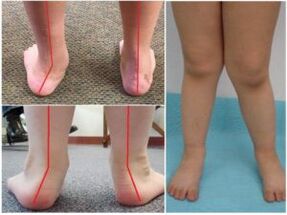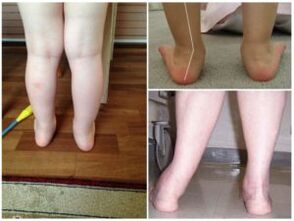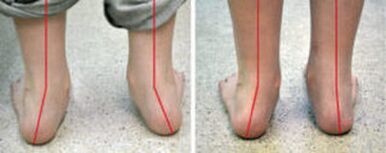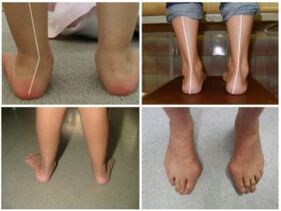Parents should pay close attention to the physical development of their children in order to regulate timely deficiencies.Deformation of the foot valgus in children is a frequent pathology.Although the defect is congenital or acquired, the methods of diagnosing, prevention and correction are similar.
What is a valgus foot and flat-valgus

The term valgus doctors indicate any curvature of the joints inside the middle line (axis), in which an "X -shaped" deviation is visible.The most pronounced example of the pathology is bones in the thumb (Hallux valgus).Valgus deformation, which is shortened as "valgus foot" (sun) is the wrong placement of the foot in horizontal support.If the one -sided child puts the legs together, then the back is visible as the interior ankle is moved closer to the opposite limbs, and the heel deflected the outside.At the same time, a flat child rests mainly on the inner (medial) leg.Therefore, the plantar region, as they were, "looks" outside.A variety of disease is a flat-valgus foot (PVS).Combines flat legs with X -shaped bending. In the baby, in addition to the formation of deformation, the group of the foot is gradually flattened.
The rate of curvature of the valgus
The phase of the neglect of the pathology is determined by the size of the angle of deviation of the heel from the average axis.
There are 4 degrees of illness:
- I - up to 15 °;
- II - 15‑19 °;
- III - 20, 29 °;
- IV - 30 ° or more.
1-2 phase of valgus deformation can be eliminated by conservative methods.At 3 degrees, prolonged treatment is needed.In 4 stages, a surgical correction may be required.
Causes of deformation
There are three factors, as a result of which there is a curvature of the foot: impaired intrauterine development, chronic physical overload, diseases of the muscle system.These factors weaken the ligaments, tendons, muscles, so the foot is not fixed by them in a normal anatomical position.
Reasons for obtained valgus, flat-valgus leg (M21.0 code in ICD-10):
- Premature placement in the leg, when the baby's joints are not yet ready for such loads;
- "Wrong" shoes (narrow block with a thin thin heel, without supinators).
- muscle hypotension, congenital myodyistrophy;
- great weight, overweight;
- Rike;
- Neuromuscular diseases (poliomyelitis, cerebral palsy of children, polneuropathy of various etiologies);
- congenital thigh displacement and hip joint dysplasia;
- trauma in the leg or lower leg;
- Long -term immobilization of the foot with gypsum, teacher or pillow of Freik.
Congenital origin of the valgus and flat-valgus defect of the foot structure (code Q66.6 in ICD-10) may be due to abdominal damage transferred by a pregnant woman, or a genetic disease.Such curvature can be seen immediately after birth, sometimes manifests before the baby starts walking.
How to determine the deformation of the prohibition

A change in the configuration of the lower extremities is located along the axis of the foot.This is the name of the conventional line, visually drawn from the center of the hip node through the knee, the ankle in the middle of the calcaneus.The rate means passing the axis through the center of the nodes that should not be moved from it to the right or left.
The characteristic features
In newborn babies, with the innate nature of Valgus, it is found immediately or in the first months of life.Most often, signs of a valgus defect in children appear after a year and a half.The presence of the disease may be suspected of behaving and walking the baby.Most often, the following general symptoms of pathology are found:
- Increased flexibility of small joints of the joints;
- lowering the height of the single group;
- Shifting the center of gravity (when trying to walk, the child rests solely on the medial side of the foot, its outer edge can grow slightly);
- unsafe, walking moving;
- Rapid physical fatigue, the need for rest, to give the child rest;
- regular complaints of leg pain, unwillingness to walk;
- slight swelling and redness of the skin and ankle;
- Uneven shoe dressing, more expressed by the single interior edge.
Methodology for identifying deformation
The methods of diagnosing defect include an examination with an orthopedic baby's foot, followed by the baby's direction for instrumental examination.It has become an X radius of the legs in three projections to detect the degree of bone displacement.They also perform a planetography to determine the height of the aroma and the degree of severity of the flat legs.Using the post -meter, the pressure center is calculated in the only one.This is an effective diagnostic method, as it allows you to identify valgus deformations in the early stages.Sometimes, to clarify the exam results, an ultrasound of the foot becomes.The visual signs of the pathology are the only one, slightly turned and raised in the side direction, the shift of the heel, the outer line from the middle line.With flat-valgus deformation, the eradication of the safe, flattening of the foot is marked.To rule out the neurological causes of the defect, the orthopedist directs the child to a close specialist.
Correction methods
To eliminate the valgus, the main tasks are to give the foot of the correct position and the subsequent strengthening of the ligaments attached to the heel and muscle tendons.
Fastening the fusion in a conservative manner
With an innate defect, gypsum or tutors are used.The purpose of solid foot fixing at the right angle is to eliminate bending by immobilization.As the oshification is not completed, the fabrics are elastic, so they are easily suitable for such a correction.With the fault obtained valgus, to return the correct foot placement, the orthopedic shoes are made to the baby.Should not cause discomfort when used.A special shoe bed has solid lateral supercinators, a soft pillow (pelot) under the leg.Such shoes are also recommended to be worn during post -operative rehabilitation and to consolidate treatment results.
A variety of bedding with one valgus foot
Experts recommend ordering orthoses, shoes or bedding for children in orthopedic salons according to individual sizes and foot castles.Product price will be slightly higher, but use will give a more noticeable result.
Strengthening small joints

For the overall hardening muscles and tonic of the lower extremities, it is recommended to use the opposite leg baths.For this, the legs are alternately immersed in a container of cold, hot water.They start with a temperature of 36 ° C with a liquid, then this value is changed every week by 1 ° C. Gradually bringing to an interval from 14 to 40 ° C.
It is useful to do the following exercises:
- Alternate walking in socks, heel, inner edges, only exterior;
- Collecting small objects, tightening fabric or paper, drawing with the toes;
- Scing the single ball on the floor;
- a set of finger exercises (bending-exting, education and closing);
- Walking into pebbles and an uneven surface.
The orthopedist may prescribe a course of massage of the lumbar spine, affected by the lower limbs or both feet.Optimal optimal to perform it after heating with paraffin or ozokerity application.The muscles of the inner surface of the legs are acted upon by tonic massage movements (patting, cooking).The outer surface of the legs should be massaged with relaxing techniques - stroke, rubbing.
Physiotherapeutic procedures
If foot deformation provoked inflammation of the articular structures, muscle tendons, the child is an electrophoresis prescribed with painkillers and anti -inflammatory drugs, magnetotherapy, black wax application, paraffin and therapeutic mud.For selective muscle stimulation, diadean currents are used.
Surgical treatment
In early childhood, no radical methods of therapy are used.But if the defect interferes with normal walking, surgery is done to young children.During surgery, doctors who use metal elements (titanium wires, screws, plates) regulate deformed joint in a normal position.Surgeons can also strengthen the joint by moving the fibula tendon or extending the Achilles tendon.Following these operations, rehabilitation involves the use of orthopedic products, massage, physiotherapy and physiotherapy exercises.
Preventive
To prevent deformity of the valgus of the foot, you need to buy a comfortable baby shoe that corresponds to the size of the foot, the anatomical structure of the foot.How to choose - check out the recommendations of E.O.Komarovsky in the video.The doctor tells the disease that this is a frequent violation in children and helps to form accurate leg that will form up to the age of 12.The young man will most likely need surgery to correct the pronounced foot defect.The child should walk barefoot in the sand, grass, walk a lot, eat completely.The sun's dose of the sun prevents rickets in children, which is one of the causes of the disease.Physical education, body strengthening, regular courses of general strengthening massage.Gymnastics for the leg muscles is also important, including creating a pattern of a foot in the sand.Active outdoor games, swimming also contributes to strengthening the muscles and ligaments of the lower extremities.All of these measures prevent the development of foot defects.It is forbidden to wear a baby's feet up to 7.5 women p .8 months, when the joints and bones of the lower extremities have not yet been strengthened.It is unacceptable to lose the planned pediatric examinations and close specialists, which allow you to identify the pathology at an early stage.
Doctors 'answers to parents' questions
How to warn Valgus's congenital deformity?Unfortunately, vice.Even if they did not find any deviation in the hospital, the child should be regularly inspected by a pediatrician, take massage, walk barefoot on an uneven but safe surface for the feet.At home, it is recommended to use a massage rug.Buying high quality shoes also helps to place the foot in the right position, to form a set of physiological heights.Such prevention will stop the progress of the valgus's congenital leg.
Which doctor treats pathology?
If necessary, the pediatrician directs the child to the children's orthopedist, traumatologist, surgeon.
What is a variable foot?
Varus deviations are the shift of the heel bone inside the middle.In this case, the group of the foot has become very high, and the pressure center is moved to the single outer edge.A defect is treated with the same methods as valgus deformation, only the angle of deviation is regulated by the opposite side of the foot.
Valgus foot deformity in children: Consequences and correction
Valgus foot deformity is a pathological change in the muscular system, in which the height of the group group is reduced, and the axis of the lower extremities is displaced.
The defect can be born or developed in childhood, leading to flat feet, behavioral violations and other health problems.As a rule, it is adjusted conservatively, during long therapy with charging, massages, physiotherapy.With regular deformation work, you can achieve proper foot placement and safe walking.
Flat-valgus leg deformation in children's symptoms
This foot defect can be recognized by the following external signs:
- The foot is filled with the inner rib, the child rests on the inside of the foot;
- The heel and fingers are placed from the outside;
- The middle part of the foot is flat or significantly lowered;
- When the knees are reduced, the legs acquire an IX-brow shape, the legs do not converge together, between them there is a distance of about 4-5 cm;
- unsafe, clumsy, child often stuck, shake;
- The child quickly gets tired on a walk.

When can a defect appear?
The arc of the foot begins to form from the moment the child tries to take the first steps.For babies, a flat foot is considered the norm.When taking a vertical position independently, children develop a skeletal muscle system, "teach" it for new functions.The bones and ligaments begin to experience loads, the foot is strengthened and takes the correct anatomical shape.This usually occurs up to 1.5 years.If at this age the vaults remains flat, there is no formed twist, doctors define this as valgus deformity of the foot.As a rule, violations are detected on medical examinations, but if your parents independently noticed the above signs, you should contact an orthopedic immediately.If you start adjusting as soon as possible, restoration is faster and without severe consequences.
cONcluSiON
Parents should devote the maximum time to prevent defects in the physical development of the baby, including gymnastics, massage courses and other recreational activities.If foot valgus deformity in children is not eliminated by conservative treatment, then you should admit that surgical intervention to correct the shape of the foot.After all, advanced pathology is fraught with the development of arthrosis, spinal cord diseases and limb shortening.























